The Porcelain Plant, Wax Plant, and many other names are used to describe the rock and tree-loving beauties known as Hoyas. This genus has hundreds of species that are easier to collect, but their price goes up as they age. If you are lucky, you’ll find propagation stems all over Etsy!
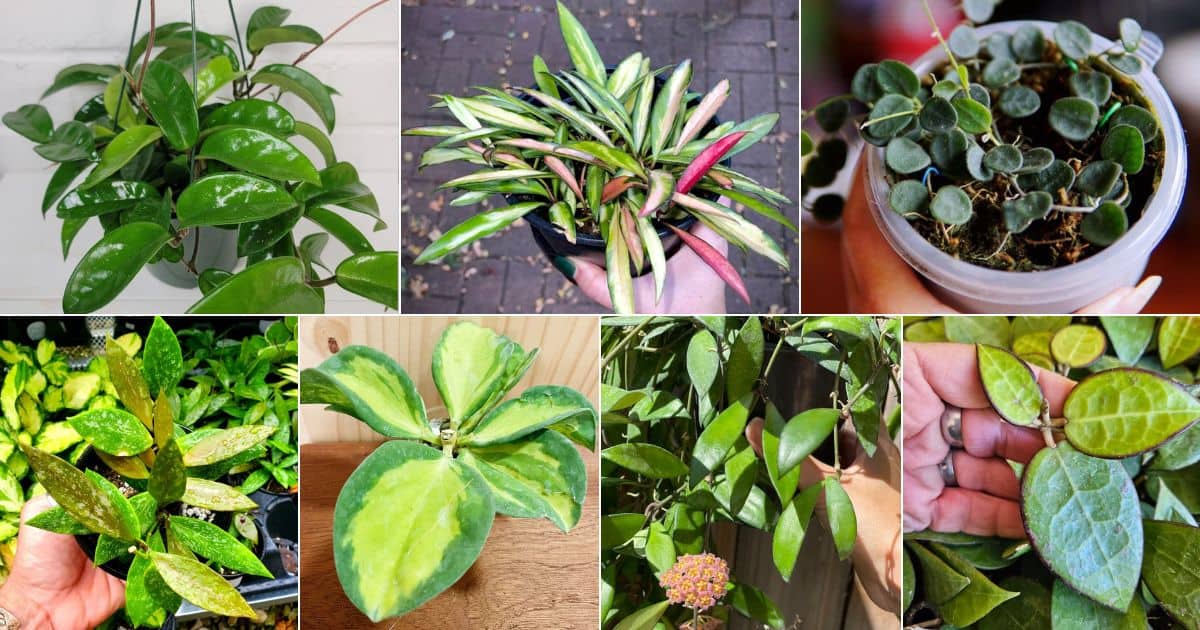
As a genus, they are rather easy to take care of, much like their full succulent cousins. That’s what also separates hoyas from the common succulents we are used to seeing at the garden store.
There are non-succulent, semi-succulent, and succulent varieties, all thanks to the varying environments that they come from. For the purpose of this collection, only succulent and semi-succulent are included.
A last note on Hoyas: these are plants that need humidity between 60% and 80%: there are several easy solutions, such as this modular humidity tray, that keeps water contained and plants happy!
Jump to:
- 1. Hoya obovata
- 2. Hoya Retusa
- 3. Hoya bilobata
- 4. Hoya Kerrii
- 5. Hoya Sigillatis
- 6. Hoya Australis
- 7. Hoya Carnosa
- 8. Hoya Multiflora
- 9. Hoya Krohniana Black
- 10. Hoya Carnosa Compacta
- 11. Hoya Serpens
- 12. Hoya parasitica ‘Black Margin’
- 13. Hoya Gracilis
- 14. Hoya Wayetii Variegated
- 15. Hoya rotundiflora
- 16. Hoya Pachyclada Variegata
- 17. Hoya Madulidii
- 18. Hoya Calycina
1. Hoya obovata
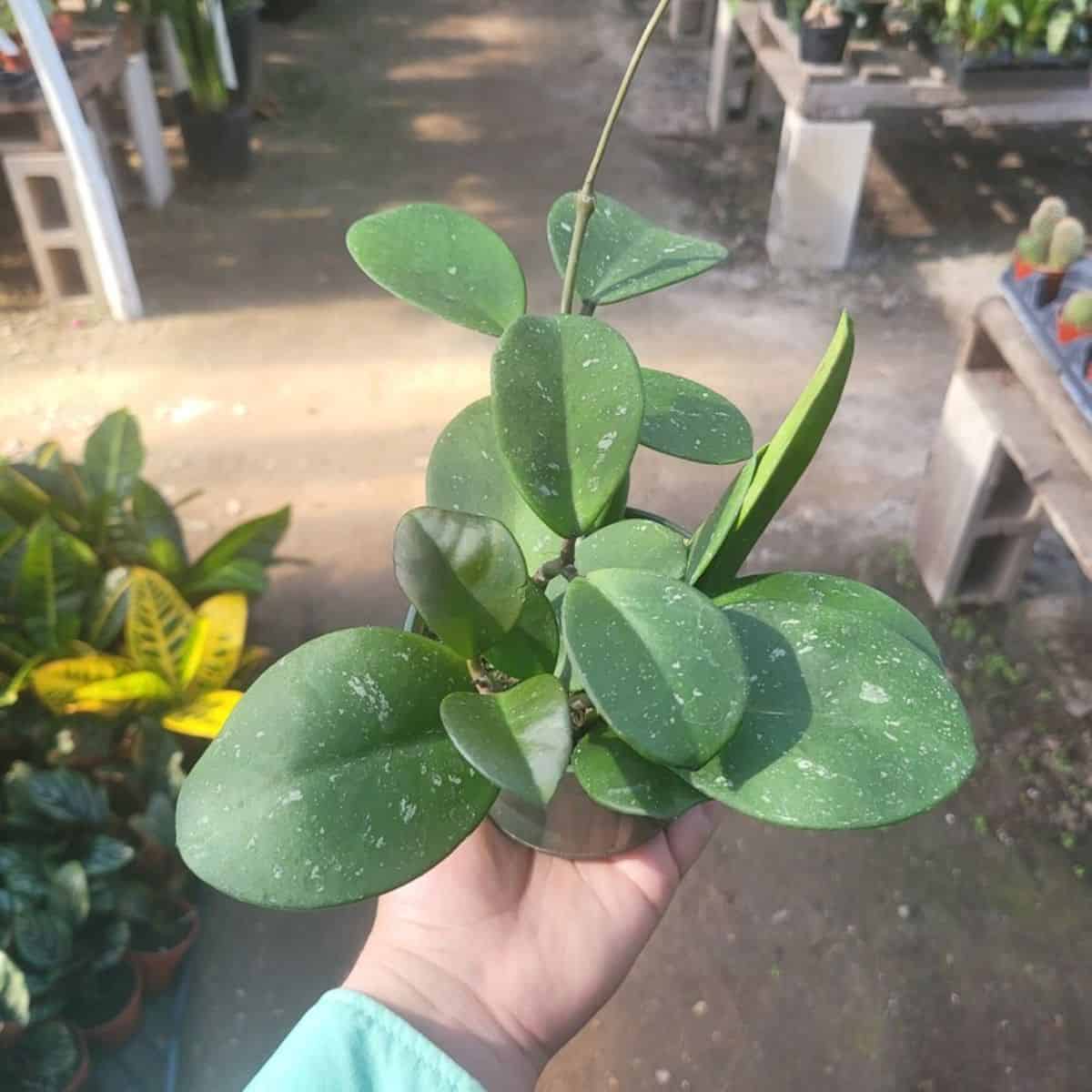
Buy it from:
| Maximum Length/Height: | Up to 20 feet |
| Watering Needs: | Only when the soil is dry |
| Soil Needs: | Well-draining soil |
| Light Needs: | Filtered sun |
| Hardiness Zone(s): | Zone 10 and up |
| Bloom Color and Shape: | The outer star is porcelain, and the inner star is maroon |
| Leaf Shape: | Oval with a dip at the top |
One of the easiest to grow for beginners and a perfect representative of a succulent hoya, this species has very thick leaves that are easy to propagate from. They have a more simple coloration to their flowers, but the leaves can vary greatly between cultivars (such as the ‘Splash’ cultivar we have listed).
2. Hoya Retusa
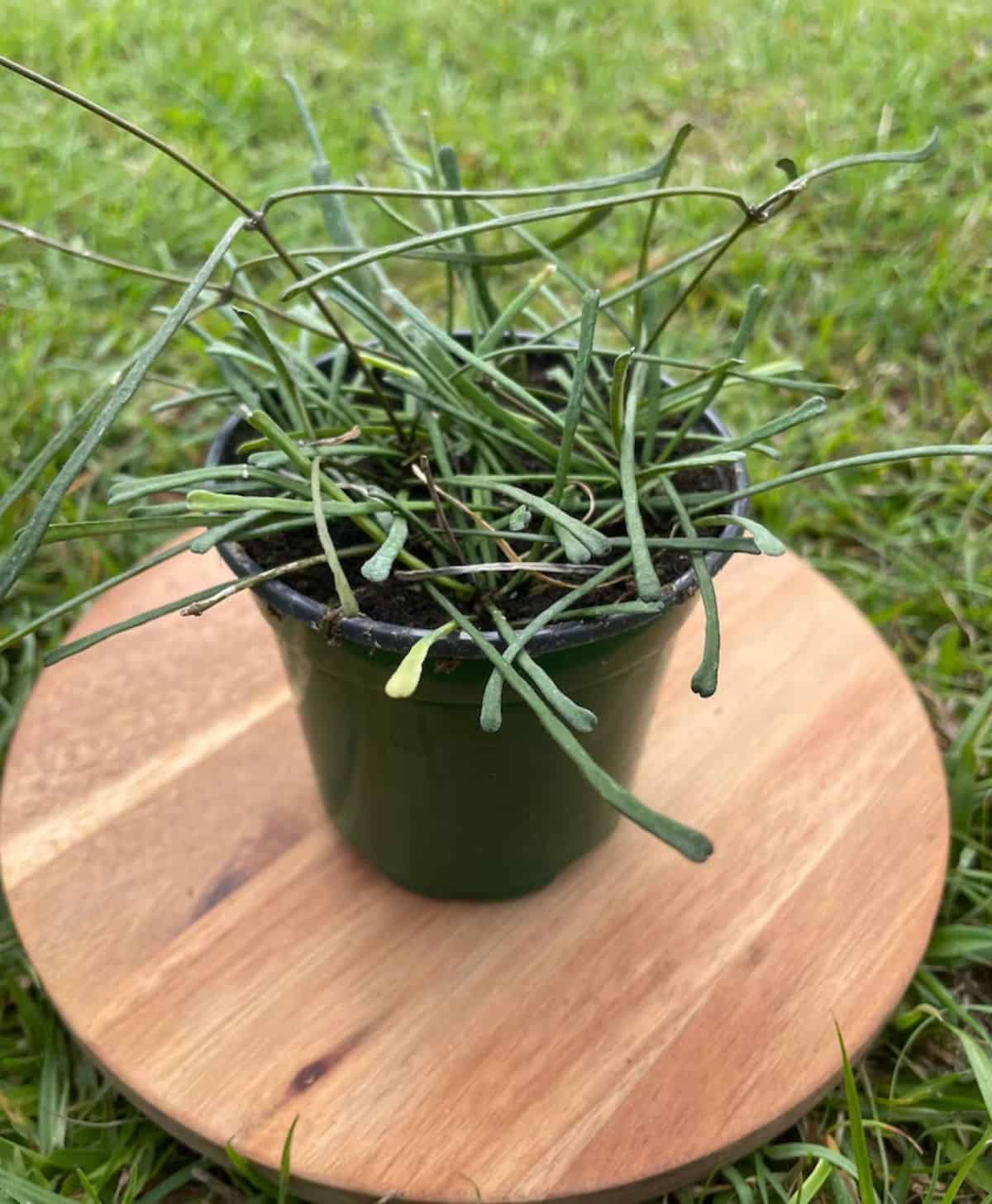
Buy it from:
| Maximum Length/Height: | Up to 10 feet |
| Watering Needs: | Only when the soil is dry |
| Soil Needs: | Well-draining soil |
| Light Needs: | Filtered sun |
| Hardiness Zone(s): | Zone 10 and up |
| Bloom Color and Shape: | Singular blooms; outer star is white and inner star is dark purple |
| Leaf Shape: | Thin and pencil-like |
Until you’ve seen a retusa it’s hard to see what thin leaves actually mean. This species not only has singular leaves shaped like elongated femurs with their double bump at the terminal end of the leaf, but it also has singular blooms. Most hoyas produce an inflorescence that holds twenty or more blooms. Retusas instead have single flowers produced all along their vines.
3. Hoya bilobata
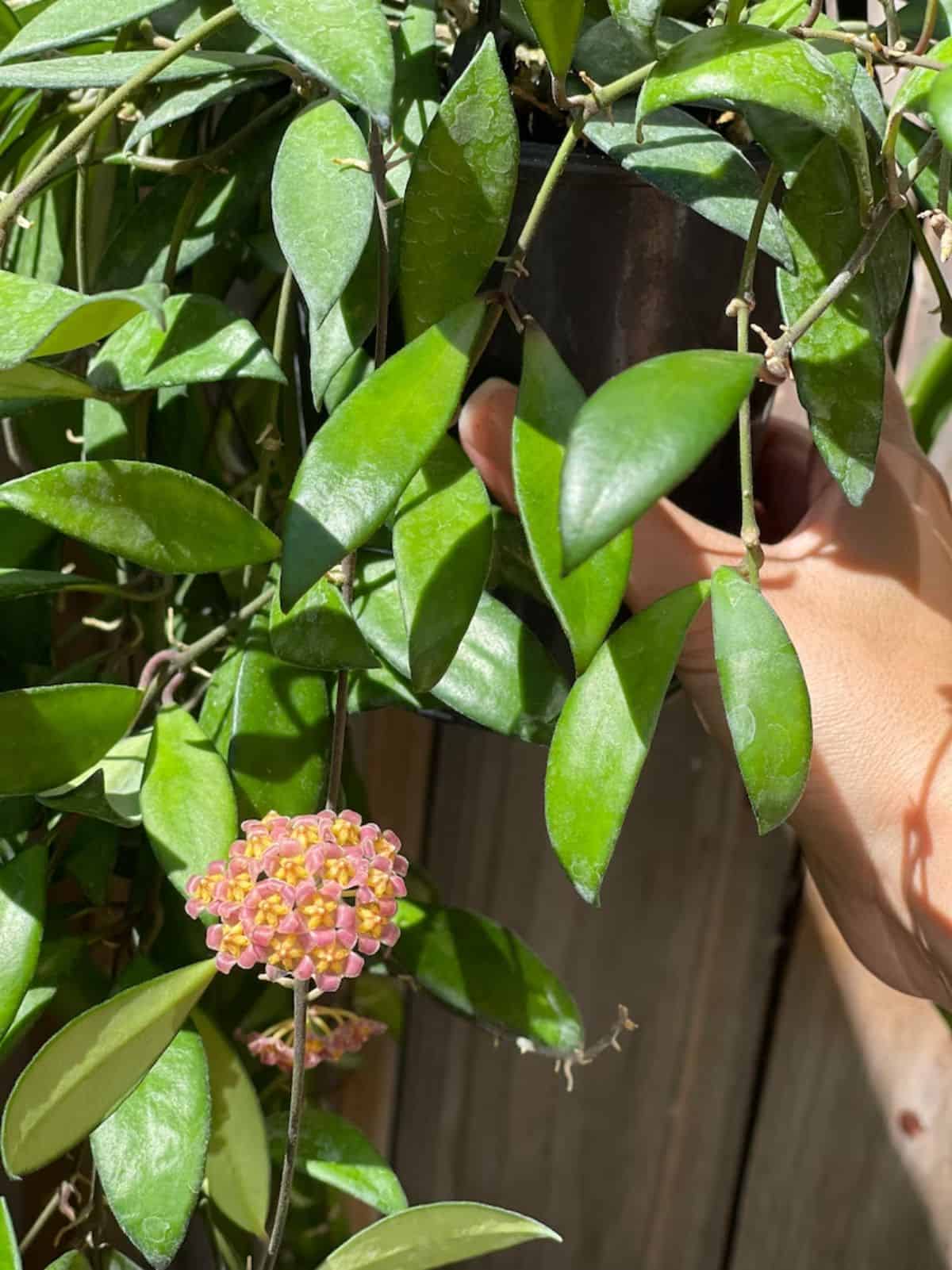
Buy it from:
| Maximum Length/Height: | Up to 24 inches long |
| Watering Needs: | Only when the soil is dry |
| Soil Needs: | Well-draining soil |
| Light Needs: | Filtered sun |
| Hardiness Zone(s): | Zone 10 and up |
| Bloom Color and Shape: | Sepal is magenta, and the inner star is red and orange; one of the smallest blooms in the genus. |
| Leaf Shape: | An elliptical shape that curls downward along the edges |
If you are a fan of the tiny, then this species is for you. Out of the over 500 species of confirmed cultivars, it has the smallest bloom out of all hoyas. It has succulent leaves that, while not as showy as other species, brighten up a room with its variation of dark green and light green leaves.
4. Hoya Kerrii
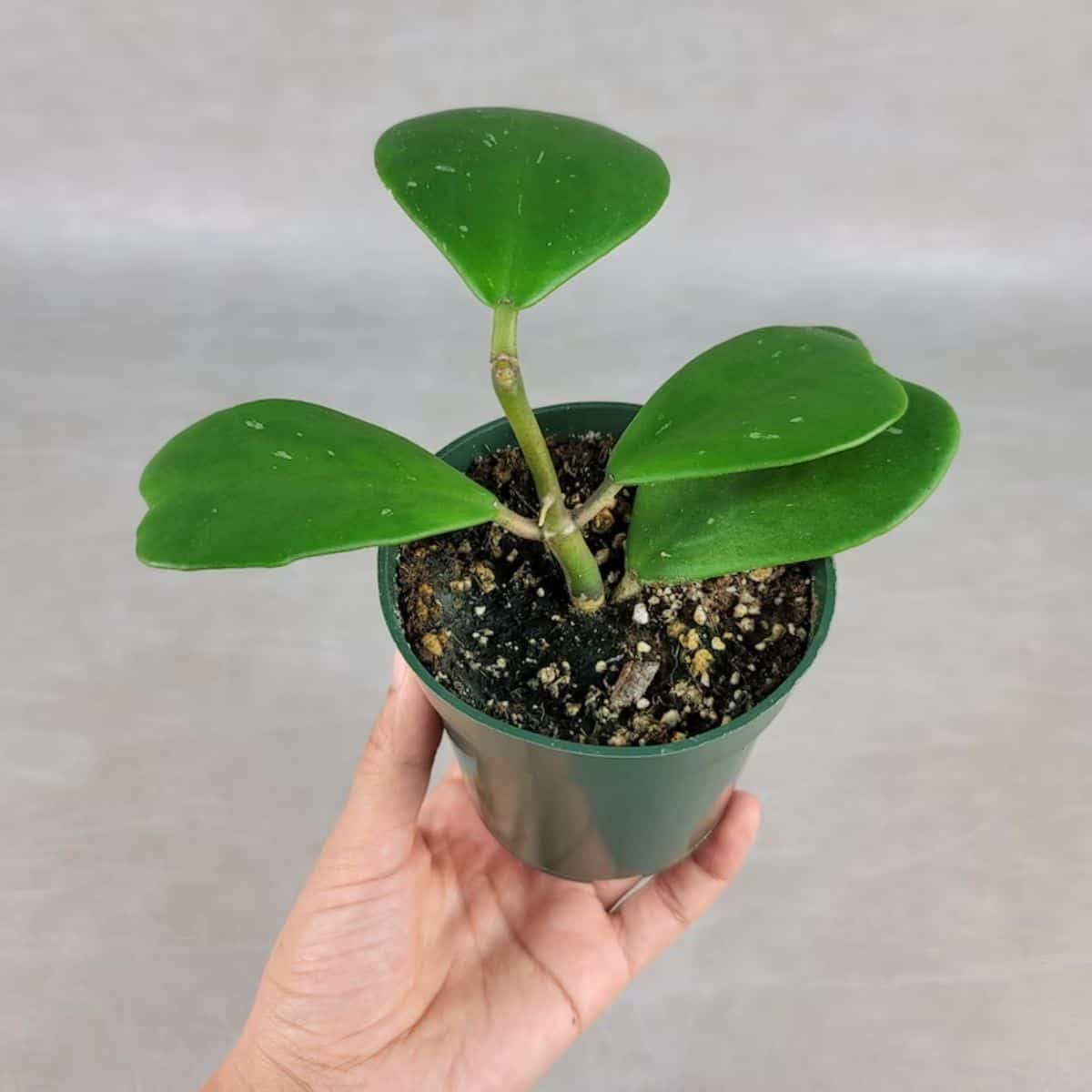
Buy it from:
| Maximum Length/Height: | Up to 13 feet long |
| Watering Needs: | Only when the soil is dry |
| Soil Needs: | Well-draining soil |
| Light Needs: | Filtered sun |
| Hardiness Zone(s): | Zone 10 and up |
| Bloom Color and Shape: | The sepal layer is white, with the inner layer that is white towards the outer edges and deep magenta in the center |
| Leaf Shape: | Heart-shaped succulent leaves |
Also known as Lucky-heart, H. kerrii is actually the first hoya that I learned about and fell in love with, pun intended. These species have the typical flower shape and color of the genus, but their heart-shaped leaves are often very prolific around Valentine’s Day. The species is so easy to propagate from a single leaf that they are sold as growing hearts around the infamous holiday.
5. Hoya Sigillatis
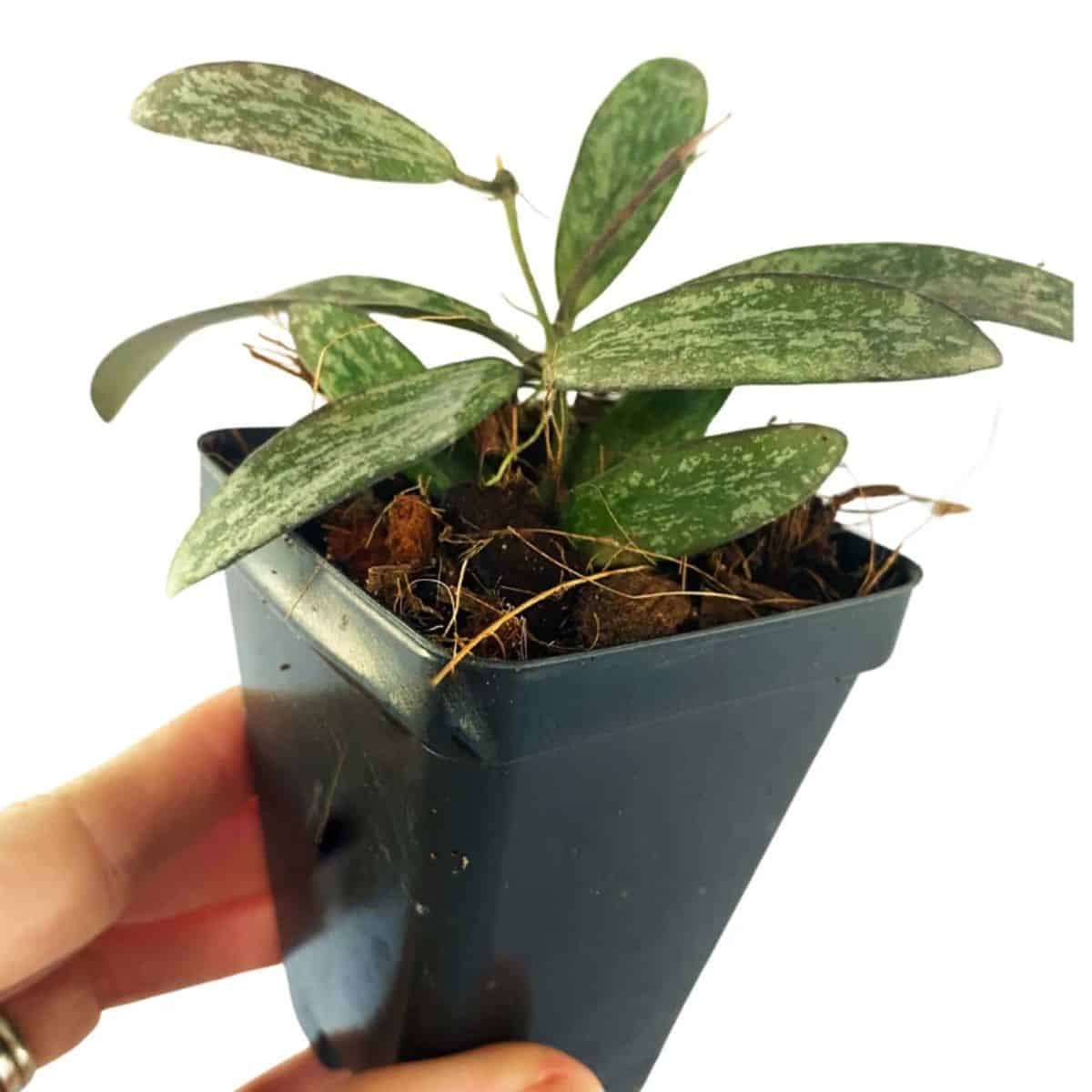
Buy it from:
| Maximum Length/Height: | Up to 10 feet long |
| Watering Needs: | Only when the soil is dry |
| Soil Needs: | Well-draining soil |
| Light Needs: | Filtered sun |
| Hardiness Zone(s): | Zone 10 and up |
| Bloom Color and Shape: | The outer sepal layer is peach colored, and the inner star leaves are a pale orange |
| Leaf Shape: | Lance-shaped with rounded edge |
Sigitalis adds more interest to a space thanks to their more lance-shaped leaves. In a way, they look like an awl as they widen towards the middle and come to a slight point at the end. They are inherently speckled with silver, and different variants will have variegation and varying splatter characteristics.
6. Hoya Australis
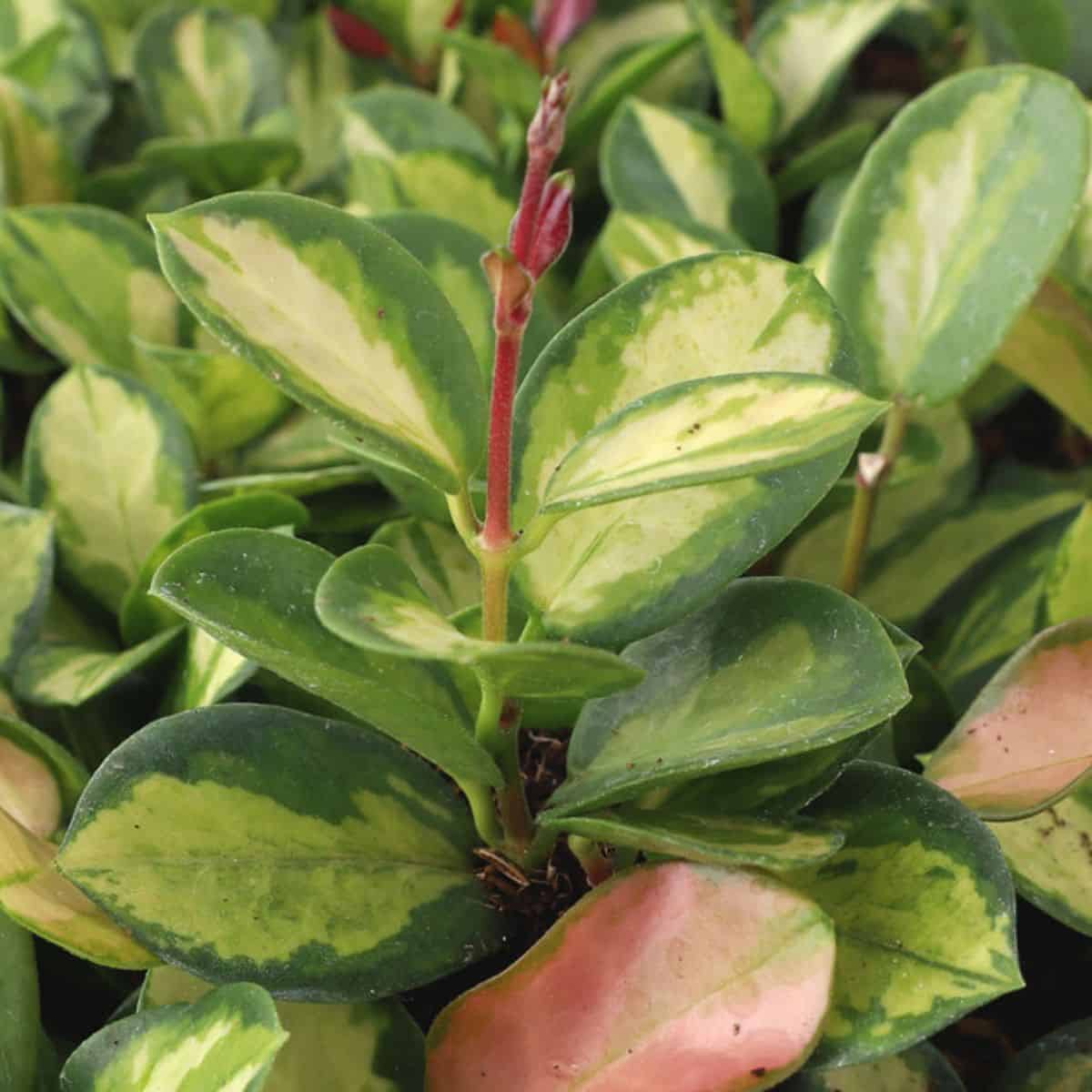
Buy it from:
| Maximum Length/Height: | Normally 10 feet in cultivation and 30 feet in the wild |
| Watering Needs: | Only when the soil is dry |
| Soil Needs: | Well-draining soil |
| Light Needs: | Filtered sun |
| Hardiness Zone(s): | Zone 10 and up |
| Bloom Color and Shape: | The first star-shaped layer is white with pink at the base, and the upper layer of the star is white. |
| Leaf Shape: | Oval shape overall with a slight tip at the end. |
The dark green leaves on this species make it a very attractive evergreen to place just about anywhere indoors. While the leaf shape is like that of a money tree leaf, what separates this species further is the way that the outer sepal layer on the flowers undulates. They almost look like the wings of birds as they are about to take off.
7. Hoya Carnosa
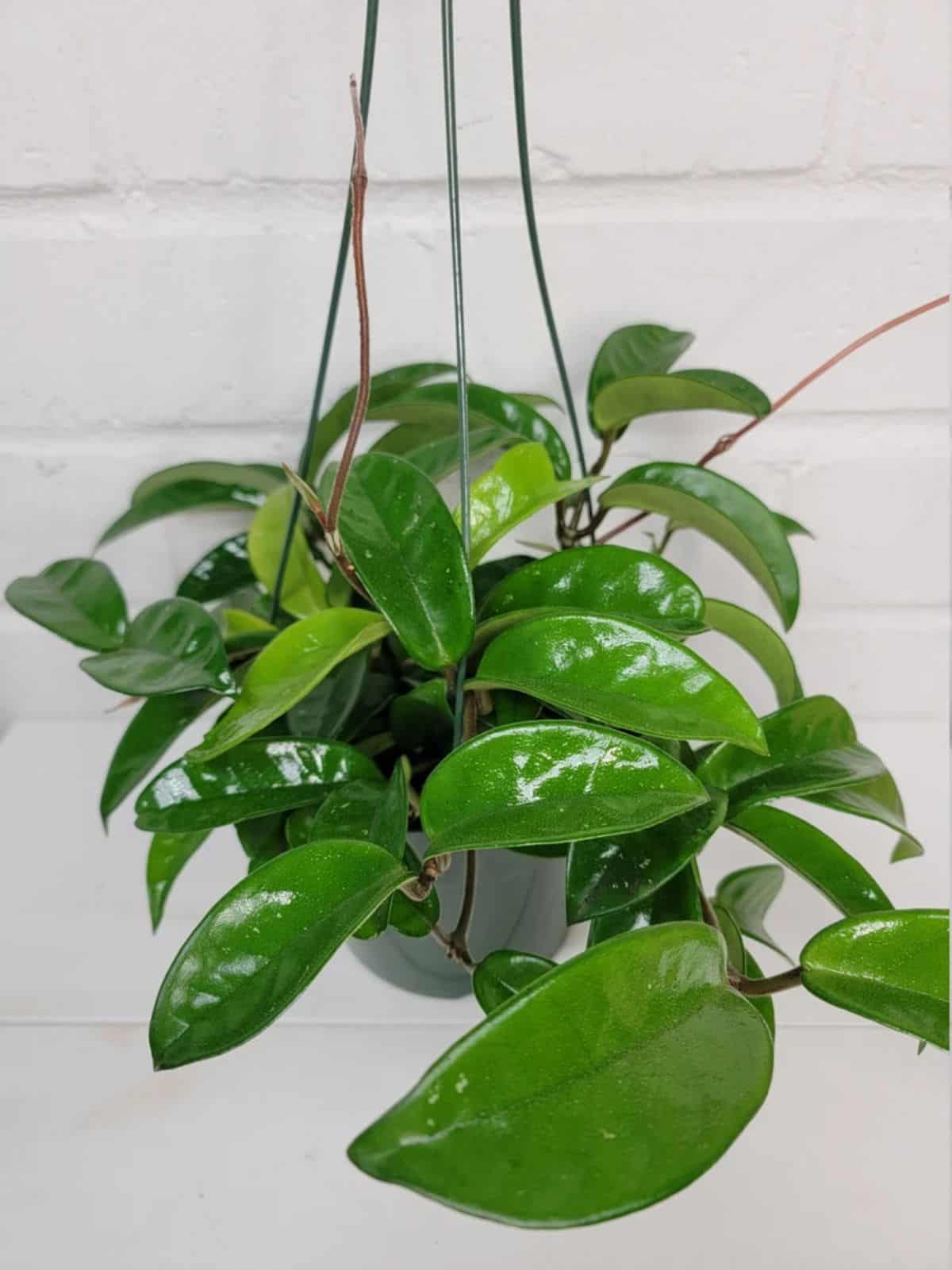
Buy it from:
| Maximum Length/Height: | Up to 4 feet on average, can get up to 13 feet long |
| Watering Needs: | Only when the soil is dry |
| Soil Needs: | Well-draining soil |
| Light Needs: | Filtered sun |
| Hardiness Zone(s): | Zone 10 and up |
| Bloom Color and Shape: | The outer layer is stark white with a center layer of star white toward the edges and an orange-red in the center |
| Leaf Shape: | Elliptical with pronounced veins |
Yet another one of the most popular species, H. carnosa has some of the most collectible variants among other species. Not only is the original plant a shiny wonder with attractive leaf shape and color, but the flowers are also heavily contrasting to the evergreen foliage. Some home horticulturists will focus only on collecting carnosa species because that is how many there are to collect in the hobby!
8. Hoya Multiflora
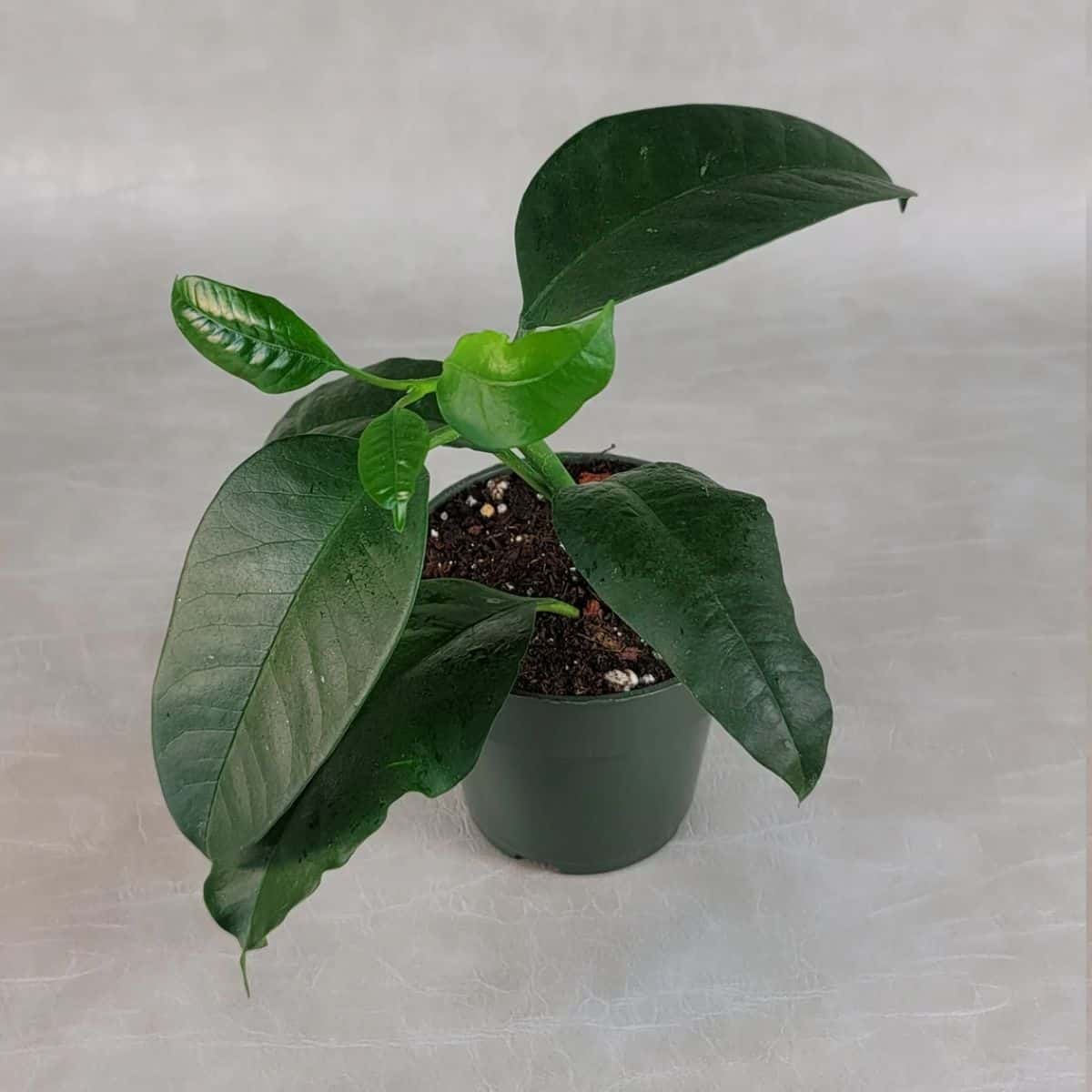
Buy it from:
| Maximum Length/Height: | Up to 8 feet in length |
| Watering Needs: | Only when the soil is dry |
| Soil Needs: | Well-draining soil |
| Light Needs: | Filtered sun |
| Hardiness Zone(s): | Zone 10 and up |
| Bloom Color and Shape: | Shaped like a shooting star. The outer layer fades from white to yellow, and the inner layer is pure white with a red center. |
| Leaf Shape: | Elongated, elliptical, and succulent leaves with a slight wave. |
The latinate name on this one confused me at first. Multiflora should mean multiple flowers, but instead, it refers to how the flowers look like they are continuing onward like a shooting star; this is where the common name of Shooting Star Hoya comes from. The flowers are fragrant like all in the genus but not as strongly scented as others.
9. Hoya Krohniana Black
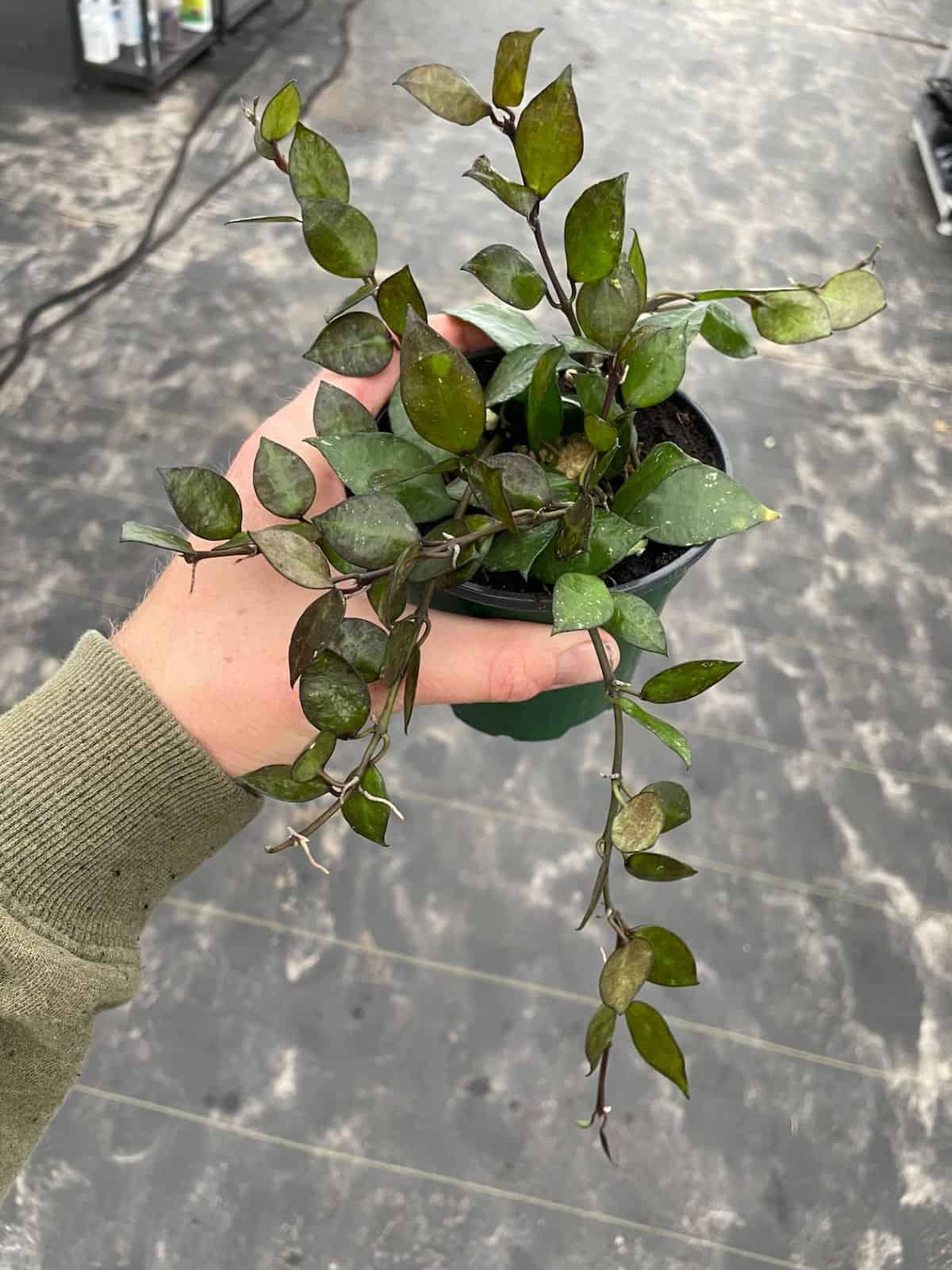
Buy it from:
| Maximum Length/Height: | Up to 3 feet |
| Watering Needs: | Only when the soil is dry |
| Soil Needs: | Well-draining soil |
| Light Needs: | Filtered sun |
| Hardiness Zone(s): | Zone 10 and up |
| Bloom Color and Shape: | The outer layer is white, and the inner layer is almost Barbie pink |
| Leaf Shape: | Smaller oval leaves that come to a teardrop tip |
For a long time, horticulturists called it Heart-Leafed lacunosa, and it was also formerly referred to as ‘Eskimo’ since this species is technically a long-standing cultivar. Personally, I am not sure where the heart leaf name came from as I couldn’t find a single specimen that demonstrated a heart shape except for the young leaves. As this species grows older, the leaves remain thick, and there can be some dark margins, but the reddish tint is more common sans sun-training.
10. Hoya Carnosa Compacta
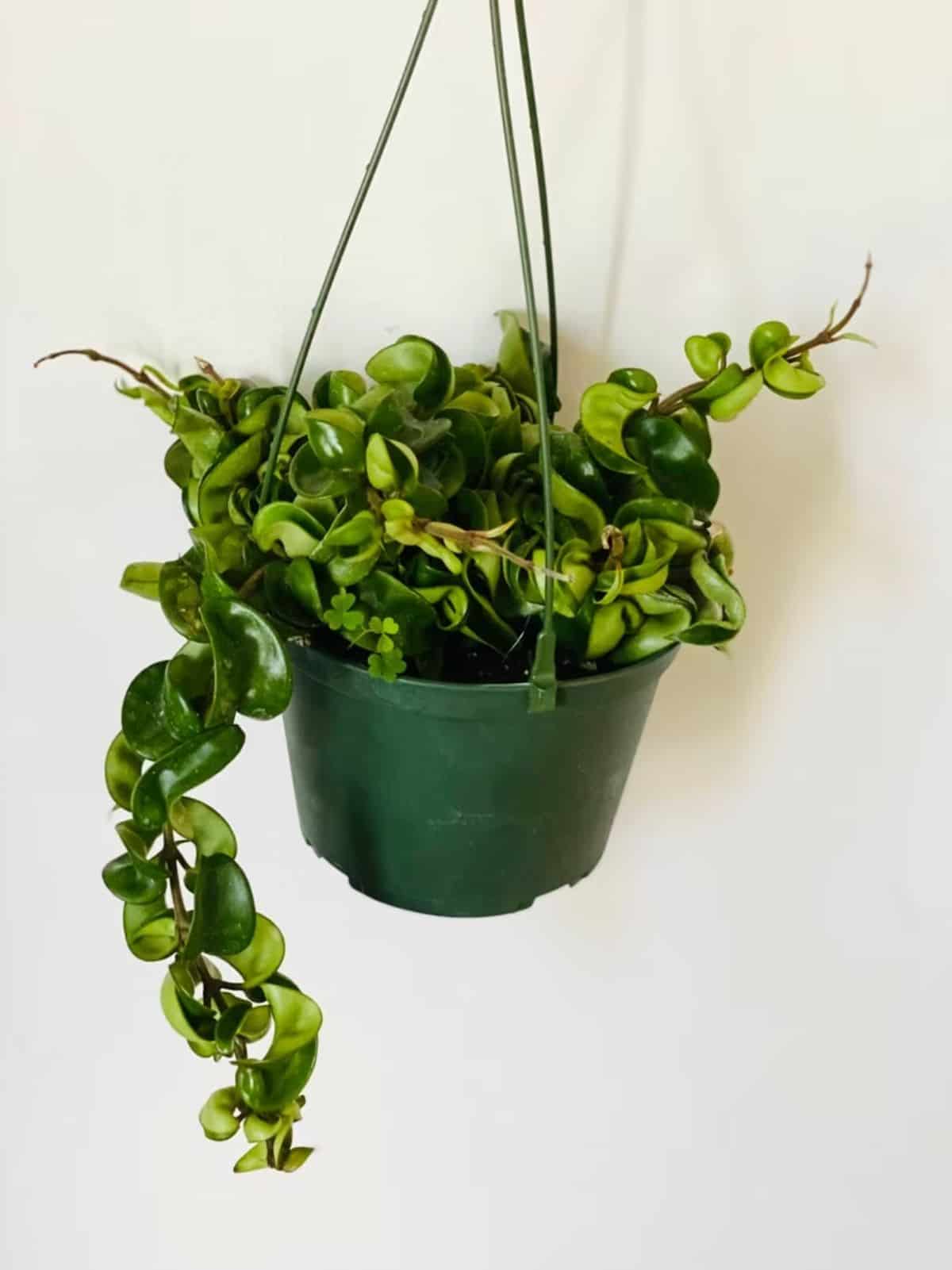
Buy it from:
| Maximum Length/Height: | Up to 4 feet on average, can get up to 13 feet long in the wild |
| Watering Needs: | Only when the soil is dry |
| Soil Needs: | Well-draining soil |
| Light Needs: | Filtered sun |
| Hardiness Zone(s): | Zone 10 and up |
| Bloom Color and Shape: | The outer layer is stark white with a center layer of star white toward the edges and an orange-red in the center |
| Leaf Shape: | Elliptical with pronounced veins and tight undulation throughout the leaves |
Called Hindu rope or Krinkle Leaf, this cultivar of Hoya carnosa had to be featured. More often than not, this is the number one species of hoya included in lists of random succulents or the most interesting succulents. While it is a succulent type hoya, it is unique even among its own genus. Having undulating leaves, almost like a crested species of succulent, is a very rare genetic anomaly that has bred true in this cultivar.
11. Hoya Serpens
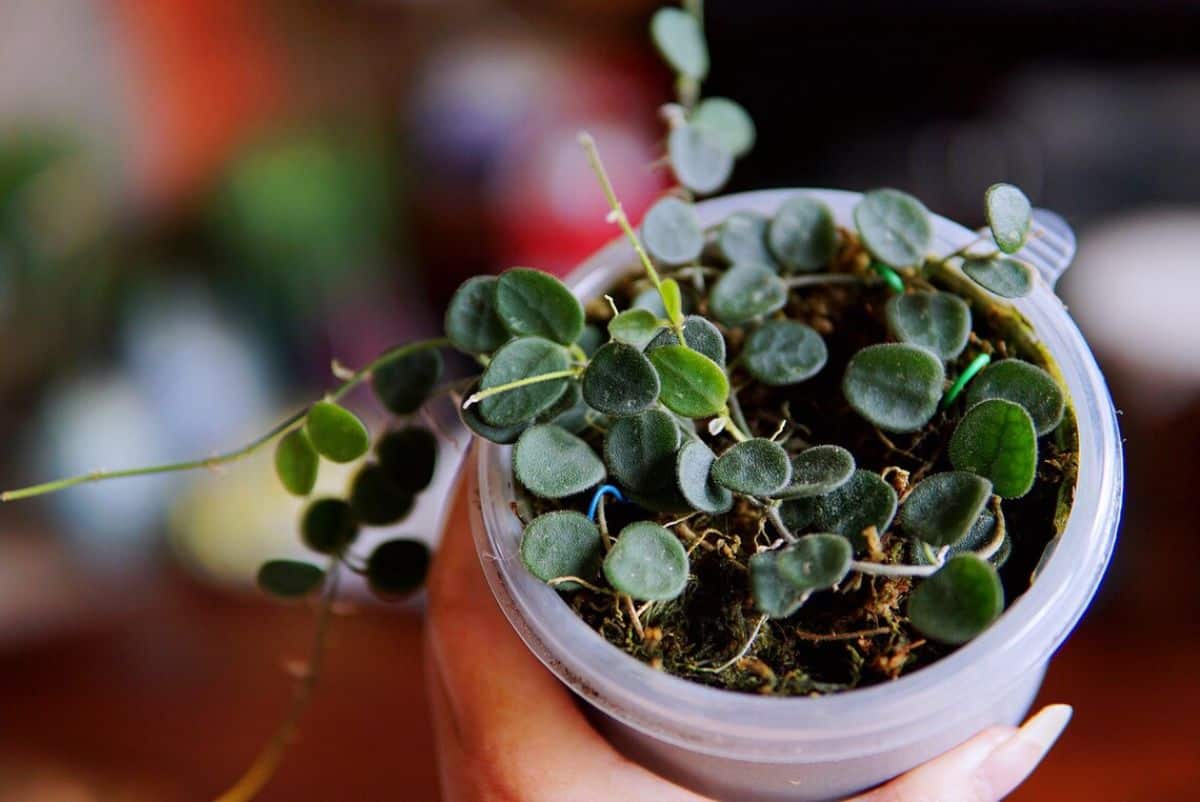
Buy it from:
| Maximum Length/Height: | Up to 10 feet |
| Watering Needs: | Only when the soil is dry |
| Soil Needs: | Well-draining soil |
| Light Needs: | Filtered sun |
| Hardiness Zone(s): | Zone 10 and up |
| Bloom Color and Shape: | The outer layer is a fuzzy green, and the inner layer is with a pink center |
| Leaf Shape: | Small round leaves |
With a name like Hoya serpens, it makes sense that this species is also called the Creeping hoya. It just likes to slither along and go on its way. A natural beauty from the Himalayas, this fuzzy flowered cutie has some of the smallest leaves and the strongest fragrance amongst others in this genus.
12. Hoya parasitica ‘Black Margin’
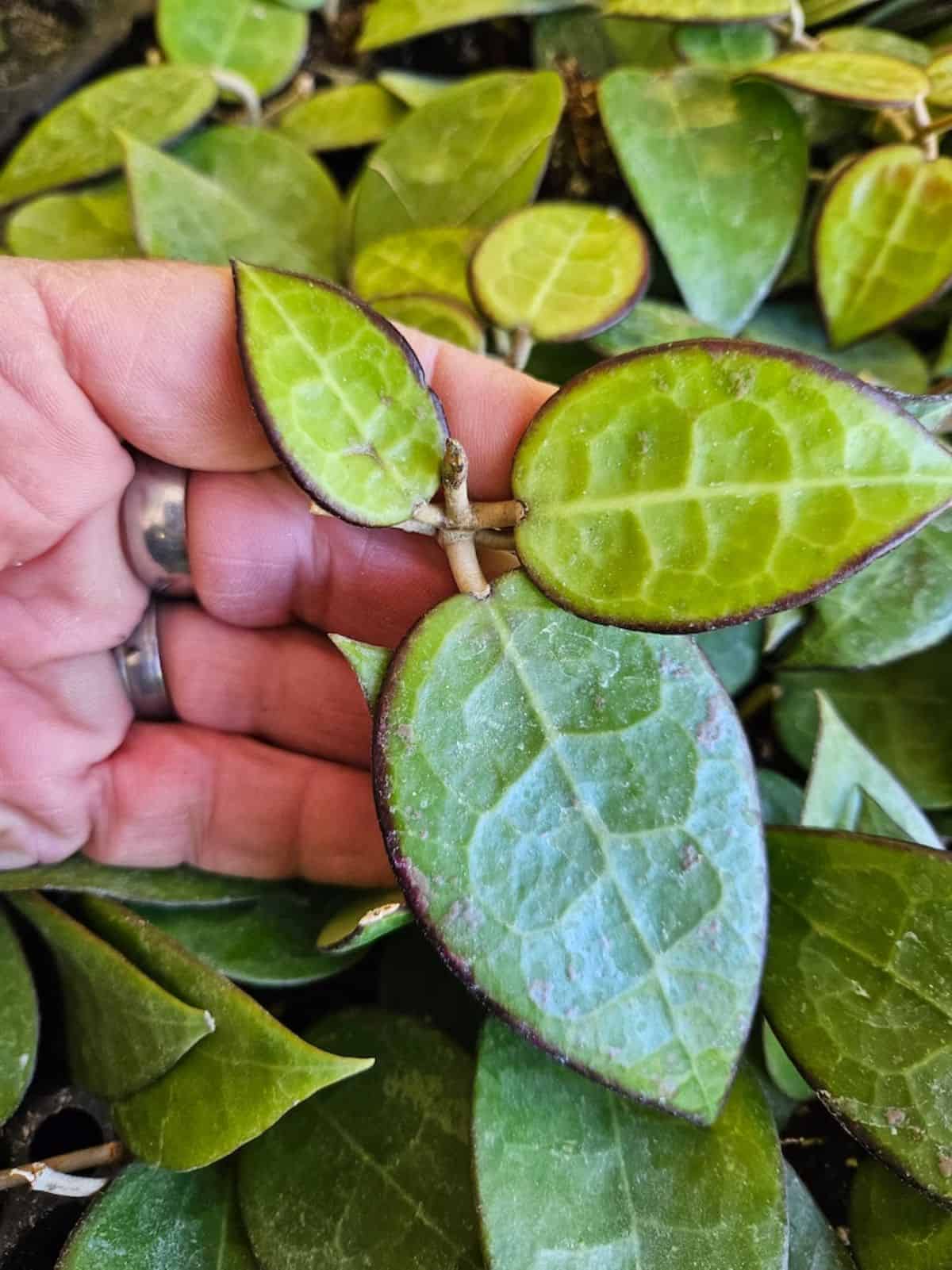
Buy it from:
| Maximum Length/Height: | Over 12 inches |
| Watering Needs: | Only when the soil is dry |
| Soil Needs: | Well-draining soil |
| Light Needs: | Filtered sun |
| Hardiness Zone(s): | Zone 10 and up |
| Bloom Color and Shape: | A creamy white outer layer with some light purple marks, and the inner star is the same color with Fuschia colored base. |
| Leaf Shape: | Elliptical with light green veins and black margins |
Out of the collection of hoyas so far, H. parasitica (both the cultivar listed and the parent plant) are some of the most beautiful foliage-wise, in my opinion. Instead of straight green with hardly pronounced veins, these leaves are not only thick and succulent, but the black margins contrast the light green veins. The non-veined tissue of the leaves is also a darker green. You essentially get a plant rainbow with each leaf!
13. Hoya Gracilis
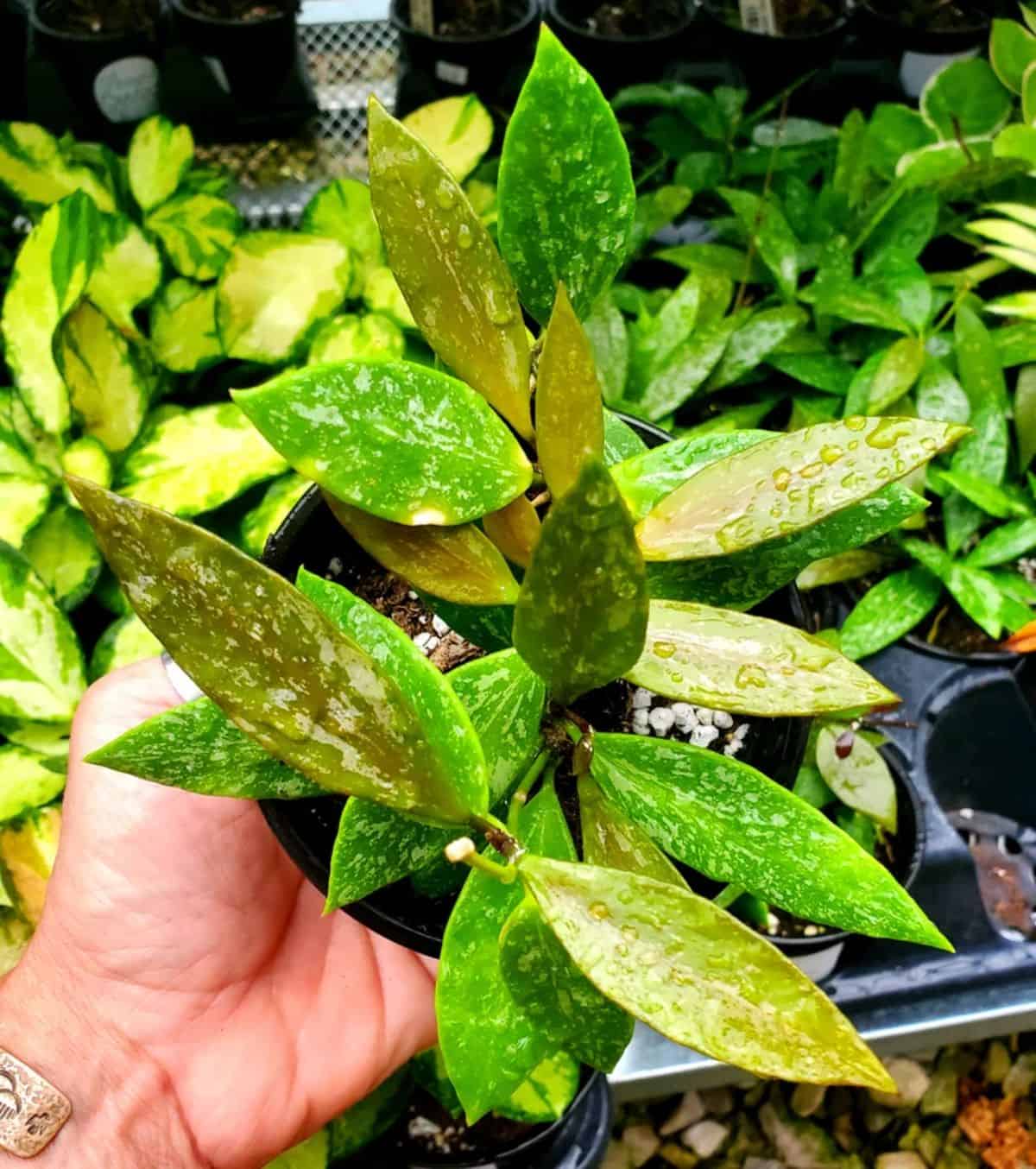
Buy it from:
| Maximum Length/Height: | Up to 3 feet long |
| Watering Needs: | Only when the soil is dry |
| Soil Needs: | Well-draining soil |
| Light Needs: | Filtered sun |
| Hardiness Zone(s): | Zone 10 and up |
| Bloom Color and Shape: | Light pink outer star with green, raised, and teardrop-shaped inner star |
| Leaf Shape: | Thick and elliptical with raised margins |
Hoya memoria is another name for this species, although it is not as commonly used. The leaves are naturally speckled with silver, which gives the species a very characteristic look. Its leaves are smaller than H. sigitalis but it has a similar speckling pattern. The easiest way to identify this species is by the inner star of its flowers. Rather than flat, they are green and teardrop shaped.
14. Hoya Wayetii Variegated
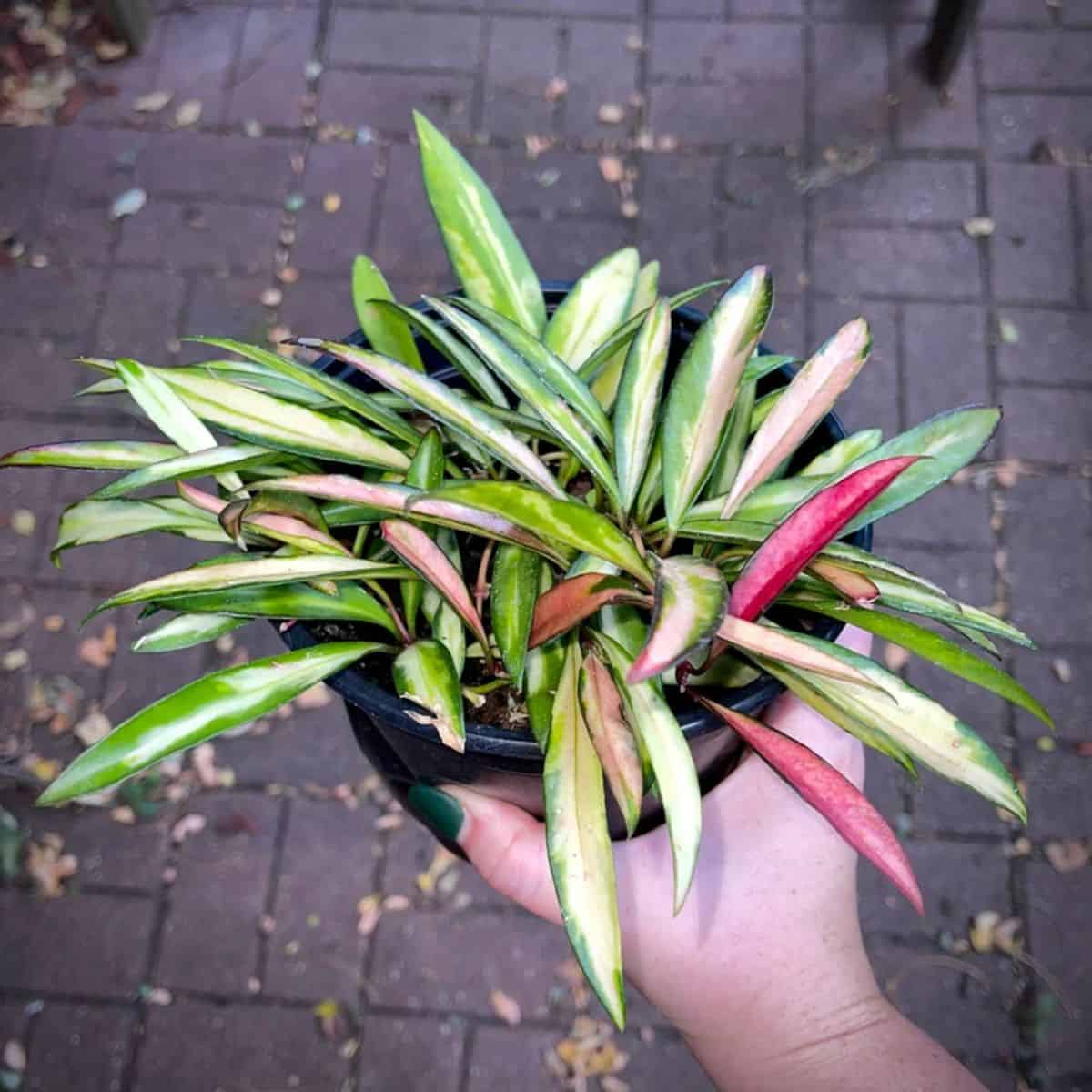
Buy it from:
| Maximum Length/Height: | Up to 3 feet long |
| Watering Needs: | Only when the soil is dry |
| Soil Needs: | Well-draining soil |
| Light Needs: | Filtered sun |
| Hardiness Zone(s): | Zone 10 and up |
| Bloom Color and Shape: | Both inner and outer star layers are red |
| Leaf Shape: | Linear and elliptical, almost shaped like a banana. Dark green margins. |
Unlike others in this species, H. wayetii has a singular color to its flowers. This doesn’t take away from it but rather adds to its individual beauty. The maroonish red contrasts the dark green margins and makes this one of the darker-themed species in the genus. The variegated version adds a pop of color that fits in perfectly with the color scheme of this gorgeous plant.
15. Hoya rotundiflora
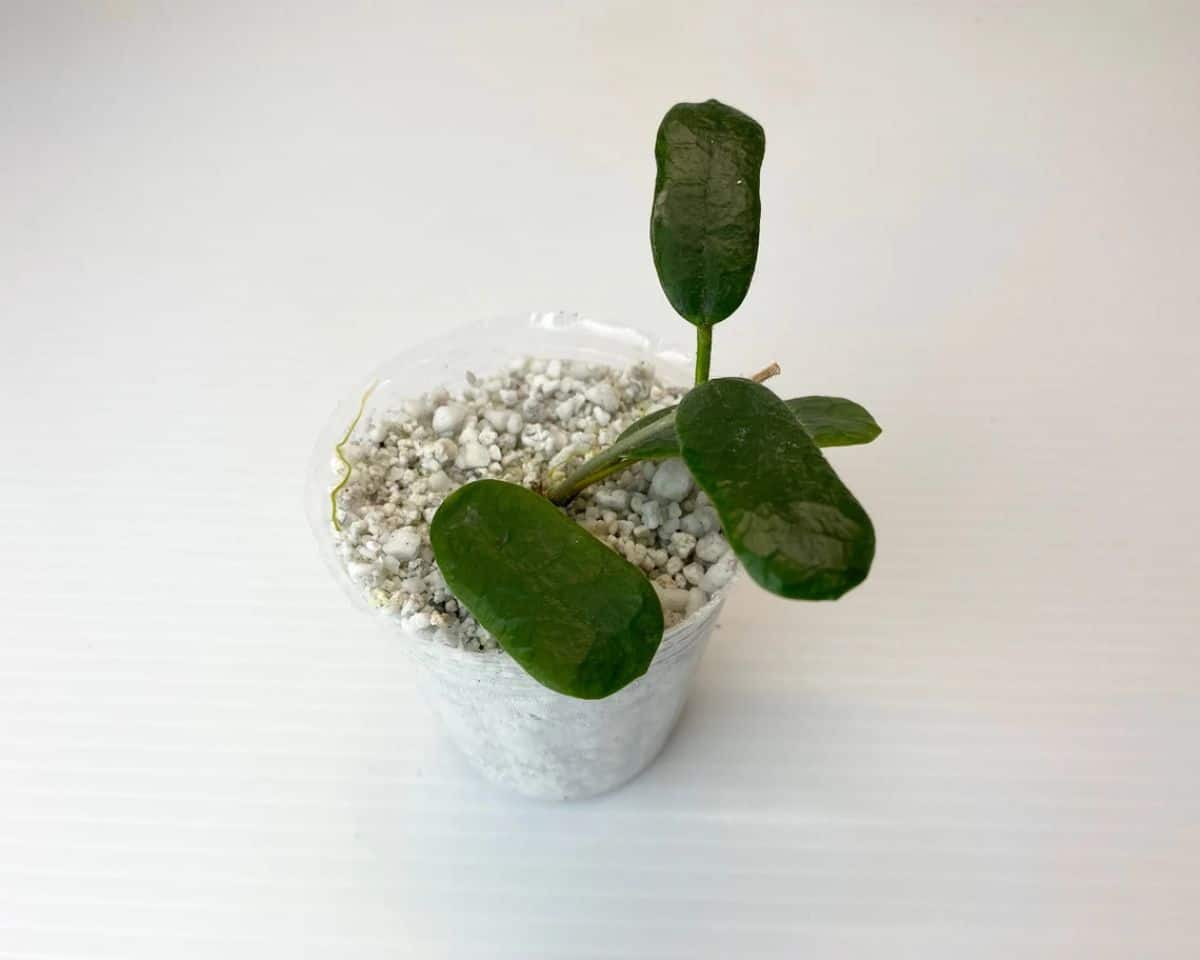
Buy it from:
| Maximum Length/Height: | Up to 20 feet long |
| Watering Needs: | Only when the soil is dry |
| Soil Needs: | Well-draining soil |
| Light Needs: | Filtered sun |
| Hardiness Zone(s): | Zone 10 and up |
| Bloom Color and Shape: | A fuzzy bulbous outer layer that is light pink. The inner star is a darker pink with fuchsia in the center |
| Leaf Shape: | Bunny ear-like leaves with pronounced veins and slightly curled succulent edges |
Now here’s a name that makes sense! H. rotundiflora is rather impressive because the sepals curl completely backward and touch at the base of the flower to form a bulbous, fuzzy, bubbly layer that is bubblegum pink. If the bubblegum flowers aren’t cute enough for you, this species also has bunny ear-shaped leaves that pop out two at a time along the vines.
16. Hoya Pachyclada Variegata
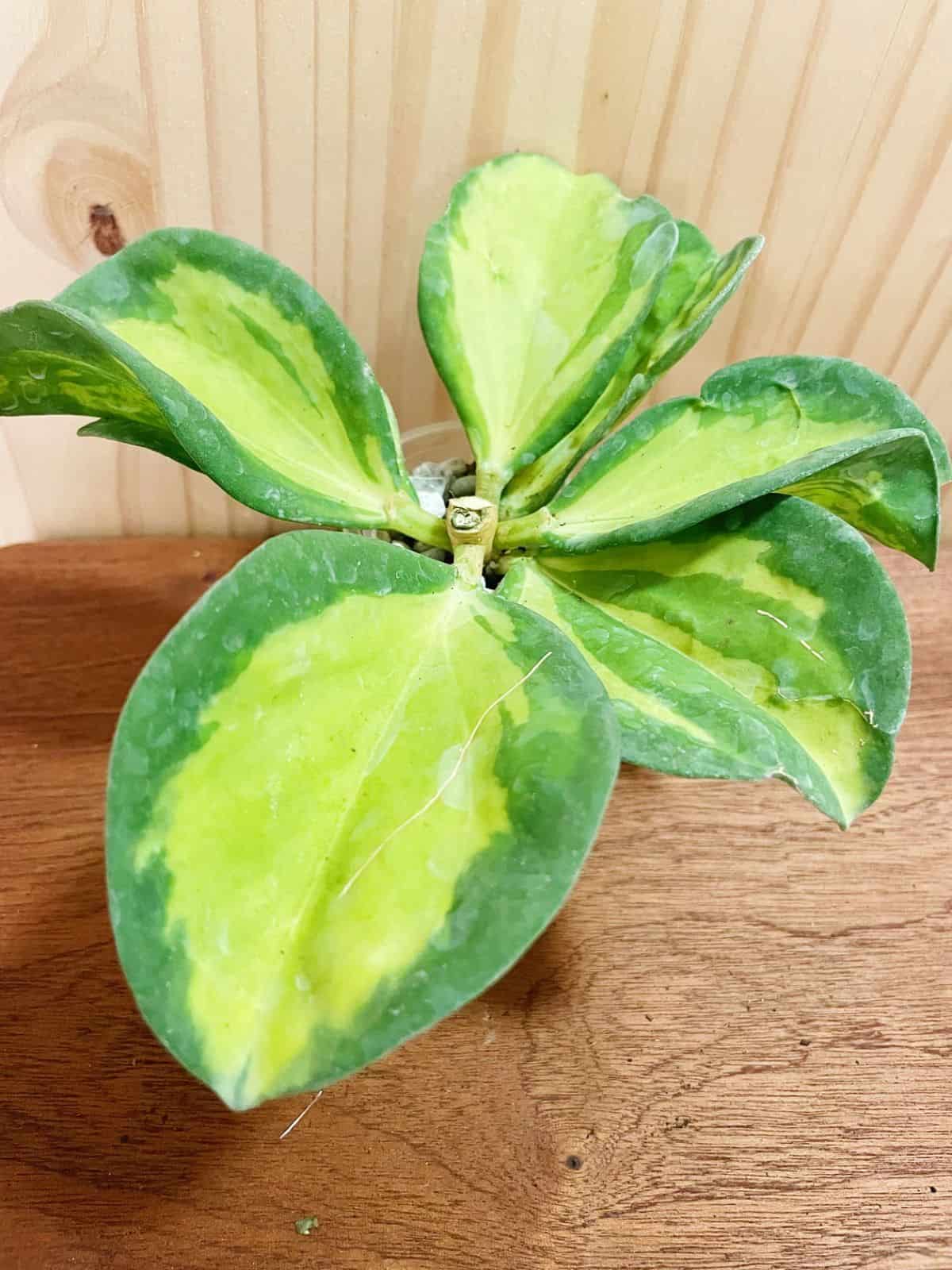
Buy it from:
| Maximum Length/Height: | Up to 60 feet |
| Watering Needs: | Only when the soil is dry |
| Soil Needs: | Well-draining soil |
| Light Needs: | Filtered sun |
| Hardiness Zone(s): | Zone 10 and up |
| Bloom Color and Shape: | Slightly curled outer lime green top with a white center, and the inner star is white with a yellow center. |
| Leaf Shape: | Smooth and thick leaves with an oval shape that ends in a point. |
The parent species of the variegated version has the same leaf shape and bloom type; it’s just so hard to avoid a variegated cultivar! The outer sepal layer on the flowers curl backward similarly to rotundiflora; however, they don’t reach around completely to touch the base of the flower. With their thick succulent leaves, they don’t need watering very often like most in this genus.
17. Hoya Madulidii
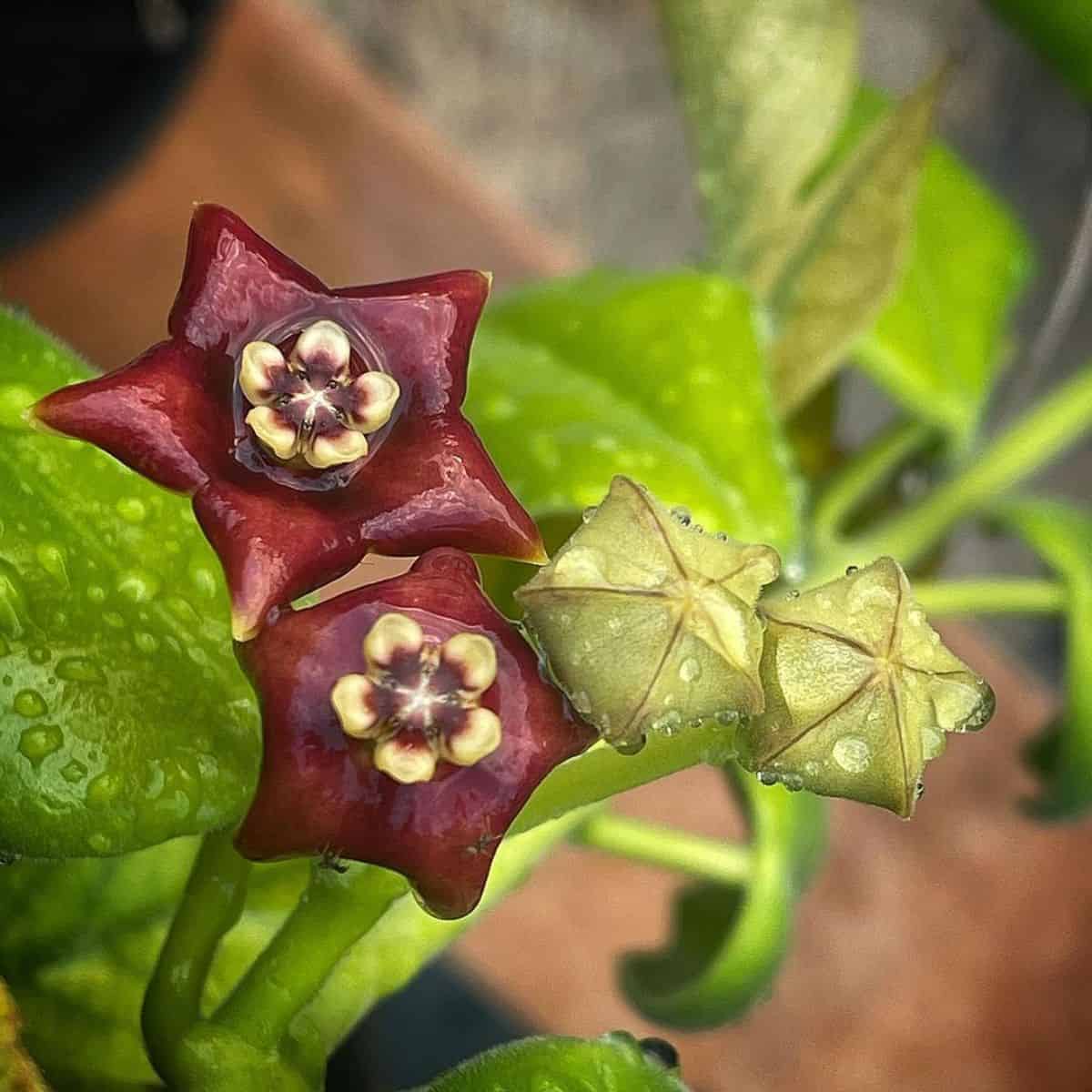
Buy it from:
| Maximum Length/Height: | Up to 10 feet |
| Watering Needs: | Only when the soil is dry |
| Soil Needs: | Well-draining soil |
| Light Needs: | Filtered sun |
| Hardiness Zone(s): | Zone 10 and up |
| Bloom Color and Shape: | The outer star is burgundy with yellow tips, and the inner star is the same. |
| Leaf Shape: | Slightly fuzzy along the edges, elliptical in shape with pronounced midvein. |
Completely veering from the traditional light blooms of hoyas, H. madulidii has deep maroon flowers with striking sunset centers. The edges are just fuzzy enough to be off-putting, as most leaves for the genus don't have cilia along the edges. What also sets this species apart is the pronounced midvein that almost folds the leaf in half
18. Hoya Calycina
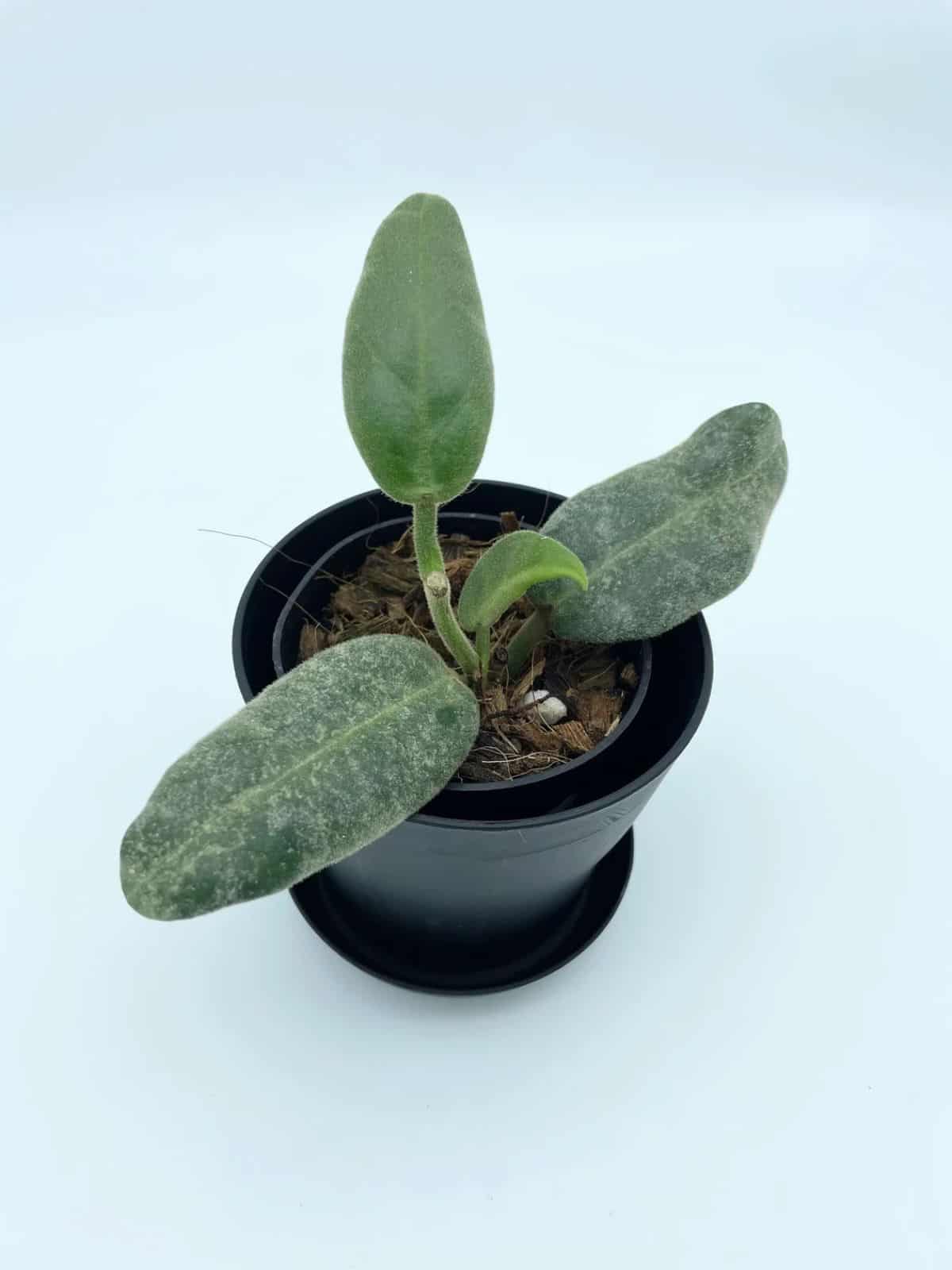
Buy it from:
| Maximum Length/Height: | Up to 10 feet |
| Watering Needs: | Only when the soil is dry |
| Soil Needs: | Well-draining soil |
| Light Needs: | Filtered sun |
| Hardiness Zone(s): | Zone 10 and up |
| Bloom Color and Shape: | The outer star layer is pure white with varying degrees of Fuschia centers. The inner star is completely white. |
| Leaf Shape: | Thick and succulent leaves that are more oval than elliptical; semi-pronounced midvein. |
Are you ready for this? Not only are the leaves covered in cilia, but each flower is also almost an inch in diameter! That’s absolutely massive for the genus! It’s also one of the few completely white flowers as well. The leaves can curl partially depending on their turgidity, and the pronounced midvein adds a lovely accent to the otherwise smooth leaf.

